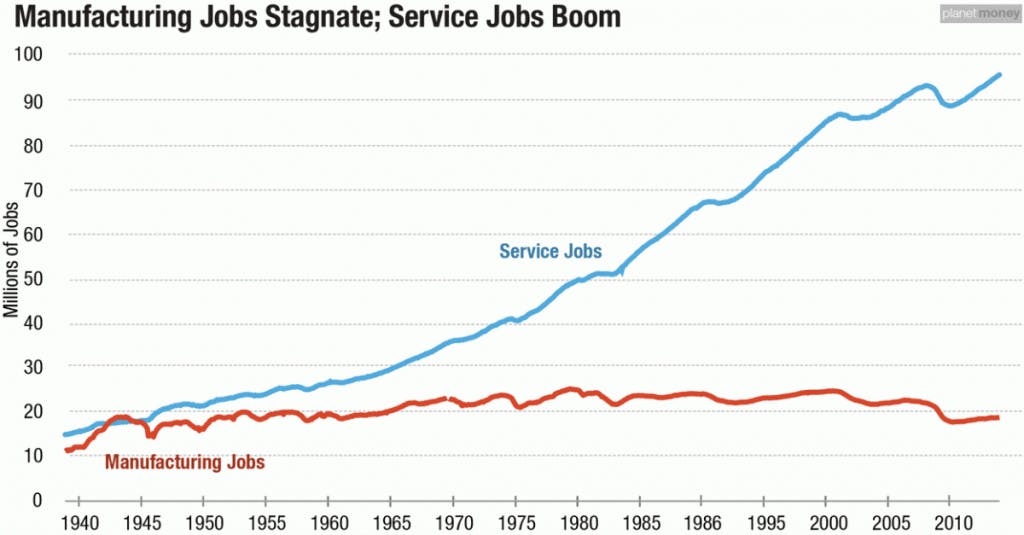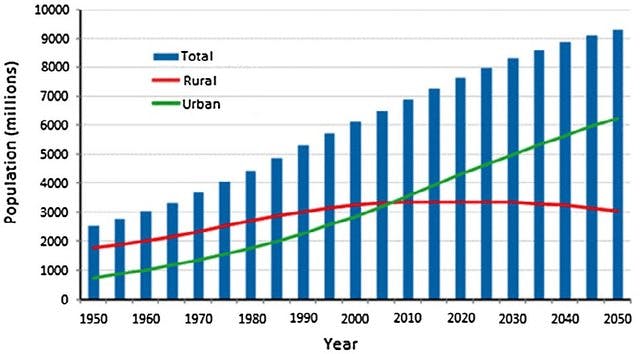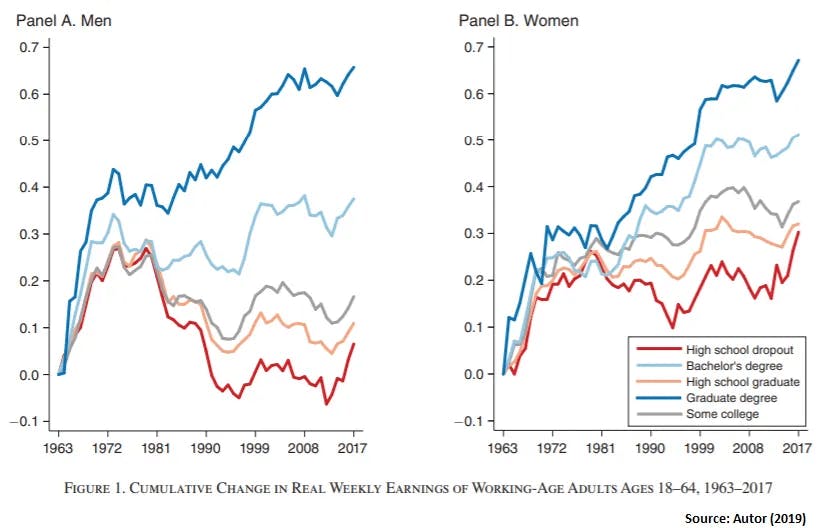We might think that location doesn’t matter in a hyper-connected, globalized world, but where you’re located matters more now than ever. We live in a clustered world where some areas, like the mega-regions encompassing the Boston-Washington Corridor of the American Northeast, are much more powerful and protected from large-scale workforce changes than others, like rural Ohio.1 North American jobs are mostly knowledge-based, service-oriented, and done in teams. When working with and for others is in the job description, urban areas with more opportunities will win out over rural towns that rely on a single industry. As cities and mega-regions attract more people, technology hasn’t necessarily made the world as equal as we would expect.2

The number of service jobs in the USA has increased dramatically over the past 60 years, while manufacturing jobs have not grown.3

The world’s population is concentrated in urban areas, and this trend is increasing in the coming decades.4
Unfortunately, this means workers in rural areas may be left behind due to the kind of geographic, demographic, and workforce changes that automation brings.5 Of all the groups at risk of automation, older workers in rural areas have the darkest forecast. With few other job opportunities in the region and less flexible education, older, rural workers will face the difficult decision of uprooting their lives and reinventing themselves if rural industries like car manufacturing face automation. Indeed, we may all start rushing into already-packed cities and leaving rural zones even farther behind as AI deepens the divide between areas with and without opportunities.
Our housing needs could change as working from home becomes the norm
Yet, perhaps we don’t all need to move to big cities to bounce back from automation. Technology may not have given every location equal value, but it has given us many opportunities to work remotely and start businesses at home. From woodworking to welding to web design, there are many ways to take up a side hustle (or a new, more fulfilling career) from a distance.
As I’ve learned in the past two months, our homes aren’t set up for daily remote work. When you can pass through the front entrance, den, kitchen, and dining room in six steps without any doorways, there simply isn’t enough room to do everything from home — and if our work situation changes, our idea of acceptable living spaces will change too. Even though automation may drive us towards big cities, changing needs in our homes might make tiny apartments less attractive than they currently are. The size and layout of our houses will need a significant change if we spend all of our waking hours at home.
Facing educational inequality, we might flock to online learning to fill the gaps
Most of the conversation around automation focuses on the new, technical skills we can learn. Many of us could certainly use some of the benefits gained from learning to code; namely, increased creativity, better logic, and greater analytical ability. But asking everyone to learn how to code will not remedy the problems surrounding automation.
As it turns out, the level of education workers have seems to be more important for adapting to automation than their specific field of study or technical skills. Workers in lower-skilled jobs,6 who dropped out of high-school or university, are at a significant disadvantage in employment and salaries compared to their counterparts who completed their schooling.7

Wages per week for men and women in the USA with different education levels.7
Above, you can see that men who dropped out of high school had the same inflation-adjusted wages in 2017 as they did in 1963. They were no better off three years ago than 57 years ago, despite considerable increases in the overall wealth of the United States. People with graduate degrees are now making 70% more than they did in the 1960s, widening the inequality between people with different education levels.
In a survey of the top US economists by the University of Chicago, 81% of respondents agreed that one of the leading reasons for increasing income inequality is technological change that affects low-skilled workers more than high-skilled workers.8 This is referred to as ‘skill-biased technological change’, where technological advancements increase demand for skilled workers, raising their wages faster than their low skilled counterparts. This skill-based change means our chances of avoiding automation can be increased by completing a half-finished high school diploma or college degree, either of which might have online options. This online flexibility can make going back to school more convenient and more common for those who might not have access to traditional in-person education.
Takeaways
Our careers partly shape our lifestyle decisions. Like dropping a stone into a calm pond, changes at work spill over into our home life. Automation is doing the same. A shift in our work, like the changes to our work environments brought on by automation, could mean the neighborhood we live in doesn’t fit us anymore. We may have changing preferences on where to live if we work from home or change jobs more often, mainly if we chose our homes based on a 30-minute commuting distance from the office like many others have in the past.9
We need to start planning for how automation will change our lives outside of work. When choosing where to live, what home to move into, and what degree to pursue, first check if your choices can help automation-proof your future. What’s the best location for your job and other opportunities, should your position get automated? What type of educational background will help you ride the wave of skill-biased change coming to the work world? These questions may come up sooner than you think. Because in many ways, the automated future has already arrived.
References
- The World is Spiky. (2005, October). The Atlantic, Retrieved from https://www.theatlantic.com/past/docs/images/issues/200510/world-is-spiky.pdf.
- Feiock, R. C., Jae Moon, M., & Park, H. J. (2008). Is the world “flat” or “spiky”? Rethinking the governance implications of globalization for economic development. Public Administration Review, 68(1), 24-35.
- Hartung, A. (2015). As goes Apple, so goes the nation: Jobs in the digital service economy. Forbes, Retrieved from: https://www.forbes.com/sites/adamhartung/2015/11/06/as-goes-apple-so-goes-the-nation-jobs-in-the-digital-service-economy/#28e2154a6443
- Musa, S. I., Hashim, M., & Reba, M. N. M. (2017). A review of geospatial-based urban growth models and modelling initiatives. Geocarto International, 32(8), 813-833.
- Case, A., & Deaton, A. (2017). Mortality and morbidity in the 21st century. Brookings Papers on Economic Activity, 1, 397-476.
- Artificial Intelligence, Automation, and the Economy. (2016, December) Executive Office of the President, Retrieved from https://obamawhitehouse.archives.gov/sites/whitehouse.gov/files/documents/Artificial-Intelligence-Automation-Economy.PDF.
- Autor, D.H. (2019, May). Work of the Past, Work of the Future. In AEA Papers and Proceedings, 109, 1-32.
- Initiative on Global Markets. (2012, January 24). Inequality and Skills. https://www.igmchicago.org/surveys/inequality-and-skills/
- English, J. (2019). The Commuting Principle That Shaped Urban History. CityLab, Retrieved from: https://www.citylab.com/transportation/2019/08/commute-time-city-size-transportation-urban-planning-history/597055/.



